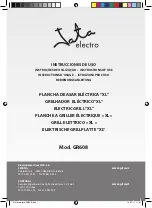
WARNING!
Read and understand all instructions
. Failure to follow all instruction
listed below, may result in electrical shock, fire and/or serious personal injury.
Work Area
1.
Keep your work area clean and well lit.
Cluttered benches and dark areas invite accidents
2. Do not operate power tools in explosive atmospheres, such as in the presences of flammable
liquids, gases, or dust.
Power tools create sparks, which may ignite the dust or fumes.
3. Keep bystanders, children and visitors away while operating a power tool.
Distractions can
cause you to loose control.
Electrical Safety
4. Double insulated tools are equipped with a polarized plug (one blade is wider than the other).
This plug will fit in a polarized outlet only one way. If the plug does not fit fully in the outlet,
reverse the plug. If it still does not fit, contact a qualified electrician to install a polarized outlet.
Do not change the plug in any way.
Double insulation eliminates the need for the three wire
grounded power cord and grounded power supply system.
5. Avoid body contact with grounded surfaces such as pipes, radiators, ranges, and refrigerator.
There is an increased risk of electrical shock if your body is grounded.
6. Don't expose power tools to rain or wet conditions.
Water entering a power tool will increase
the risk of electrical shock.
7. Do not abuse the cord. Never use the cord to carry the tools or pull the plug from the outlet.
Keep cord away from heat, oil, sharp edges or moving parts. Replace damaged cords
immediately.
Damaged cords increase the risk of electrical shock.
8. When operating a power tool outside, use an outdoor extension cord marked "W-A" or "W".
These cords are rated for outdoor use and reduce the risk of electrical shock.
Personal Safety
9. Stay alert, watch what you are doing and use common sense when operating a power tool. Do
not use tool while tired or under the influence of drugs, alcohol or medication.
A moment of
inattention while operating power tools may result in serious personal injury.
10. Dress properly. Do not wear loose clothing or jewelry. Contain long hair. Keep your hair, clothing
and gloves away from moving parts.
Loose clothes, jewelry or long hair can be caught in
moving parts.
11. Avoid accidental starting. Be sure switch is off before plugging in.
Carrying tools with your
finger on the switch or plugging in tools that have the switch on invites accidents.
12. Remove adjusting keys or switches before turning the tool on.
A wrench or a key that is left
attached to a rotating part of the tool may result in personal injury.
13. Do not overreach. Keep proper footing and balance at all times.
Proper footing and balance
enables better control of the tool in unexpected situations.
14. Use safety equipment. Always wear eye protection.
Dust mask, non-skid safety shoes, hard hat
or hearing protection must be used for appropriate conditions.
GENERAL SAFETY RULES
SAVE THESE INSTRUCTIONS
Caution:
• Tools service must be performed only by qualified repair
personal. Service or maintenance performed by unqualified
personnel could result in a risk of injury. When servicing a tool,
use only identical replacement parts. Follow instruction in the
maintenance section of this manual. Use of unauthorized parts
or failure to follow maintenance instructions may create a risk
of electric shock or injury.
1. Clean the tool housing, motor vents and blade after each
use.
2. Keep the grip dry, clean and free from oil and grease.
3. Store the tool on a safe and dry place, out of reach of
children.
4. Do not use cleaning agents or solvents that could attach
the plastic parts of the tool
MAINTENANCE
Chuck Removal
1. Open the chuck jaws fully.
2. Remove the retaining screw in the bottom of the chuck by
turning clockwise.
3. Turn the chuck counterclockwise to remove from the drive
shaft.
4. Reverse steps 1 - 3 to install new chuck.
Caution:
•
Use only Accessories that are recommended by Power
Glide for your model.
Accessories that may be suitable for one
tool may become hazardous when used on another tool.
Recommended accessories:
1. Drill bits
2. Hammer drill bits
3. Screw driving bits
4. Depth gauge
5. Chuck key
ACCESSORIES
1. Drilling in different materials:
Concrete,
- Rotate the drill / Hammer drill selector knob to
Stone,
the " " drill rotation with hammering position.
etc.
Use a Tungsten Carbide tipped bit in the center
of the desired hole location. Depress the trigger
to start drilling
Wood
-
Hold the drill firmly and place the point of the
bit in the center of the desired hole location.
Depress the trigger to start drilling.
Metal
-
Use a punch to mark hole position. Place the
point of the bit in the center of punch mark.
Depress the trigger to start drilling. Use cutting
oil in most metals to improve drilling action and
prolong bit life. See cutting oil and/or drill bit
manufacturer recommendation for use.
Plastic
-
Use high-speed steel drill bits and refer to
wood drilling.
Note: A jammed bit can often be freed by placing the drill in
reverse and slowly backing out of the work piece.
Caution:
•Always use clamps to secure the work piece when drilling.
Maximum torque often occurs at the point the bit breaks
through the work piece. Grasp the tool firmly and proceed
slowly as this occurs.






















